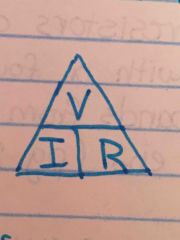![]()
![]()
![]()
Use LEFT and RIGHT arrow keys to navigate between flashcards;
Use UP and DOWN arrow keys to flip the card;
H to show hint;
A reads text to speech;
21 Cards in this Set
- Front
- Back
|
Laws of static charge |
Like charges repel Opposites attract Neutral attracted to charged |
|
|
Insulator |
don't allow electrons to move easily charge can build up |
|
|
Conductors |
Allow electrons to flow easily Charge can't be built up |
|
|
Coulomb of charge (C) |
Unit of electric charge 6.25x10 to power of 18 = 1C |
|
|
Generating static charge |
Charging object by using friction |
|
|
Charging by friction |
Rubbing two different materials together Charge transfers |
|
|
Charging by induction |
When charged object brought close to but doesn't touch neutral object
will repel electrons |
|
|
Charging by conduction |
Charging neutral object by touching to charged object |
|
|
Applications of static charge |
Saran Wrap Laser printers Decrease air pollution |
|
|
Energy |
Ability to do work |
|
|
Kinetic energy |
Moving object has because of its motion |
|
|
Potential energy |
Energy stored in object |
|
|
Potential difference |
Voltage
Amount of electric potential energy per Coloumb of charge |
|
|
How to build a cell |
Electrodes- two metal terminals
Electrolyte-conducts electricity (Wet cell= fluid) (dry cell=paste) |
|
|
Sources of electrical energy |
Friction Piezoelectric crystals Photo-electrochemical cells Themocouples Generators |
|
|
Ohms law |

V=voltage (V)-volts I=current (A)-amperes R=resistance (Ω)-ohms |
|
|
Electric current |
Amount of electrons that can pass through circuit per unit time |
|
|
Resistance |
how difficult it is for electric current to flow through conductor
Factors that affect= Type Thickness Length Temperature |
|
|
How to read a resistor |
1st band=first digit 2nd band=second digit 3rd band= # of zeroes 4th band=tolerance |
|
|
Circuit diagrams |
Source
Conductor
Load=transforms electrical energy Into other energy
Switch |
|
|
Measuring voltage and current |
Voltage=voltmeter Current=ammeter |

